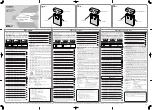
33
APR18650 Cell Vents
The APR18650 cell vents, located on the end cap(s) of the cells (on the POSITIVE side of the cell), should not be
blocked by any mechanical means. Blocking the cell vent and then sufficiently abusing the cell so as to build up
pressure in the cell prevents the cell from properly venting. Unlike the ANR26650 cell, the APR 18650 has a
protected venting structure which allows the cells to be installed end to end with no additional spacing between
them as shown in Figure 14:
Figure 14 – APR18650 cell vents
Thermal Management
A123 cells operate very well in a wide temperature range; however, they are most effective between 10 °C and
50 °C. The temperature differential between the coolest cells and the hottest cells should be no more than 10 °C.
Careful attention to thermal management is necessary to keep the cells operating at peak efficiency and avoiding
fault conditions. In most cases, this will require a cooling system. There are certain applications - such as PHEV
vehicles operating in cold climates – in which a heater is beneficial to keeping the cells operating in their optimal
range.
Cooling AMP20 Cells
When they are stacked together face to face, there are two options to cool the AMP20 cells:
1.
Using tabs as thermal conductors to draw the heat out of the cells.
The tabs are conductors of electricity
and therefore thermal conductors as well. Heat generated in the cells can conduct along the metal layers
and out through the tabs to the exterior of the cell. This method should be used only when the internal
rate of heat generation is extremely low. In laboratory testing, the measured thermal “R values” between
the inside and ambient ranged between 7 and 8 °C/W. Additionally the variation in temperature within
the cell is fairly large.
2.
Using thermally conductive plates inserted between the cells in the cells stack:
Heat can be drawn out
from the edges of the stack where it can be conducted to the air or a fluid-based heat sink. R-values in
the range from 1 to 2 °C/W have been achieved using this method. Additionally, the thermally conductive
plates keep the temperature gradient across the surfaces of the cells relatively even. The thicker and
more conductive these plates are, the better their performance will be, but the battery pack will be
heavier and occupy more volume. Those are the design tradeoffs to weigh battery pack performance
against its attributes. Figure 15 shows a general concept of using a plate and edge-situated heat sink to
cool the cells.
















































